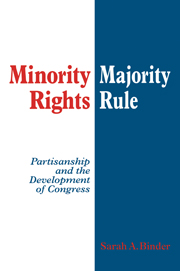Book contents
- Frontmatter
- Contents
- List of tables and figures
- Preface
- 1 The partisan basis of procedural choice
- 2 The evolving concepts of House and Senate minority rights
- 3 Procedural choice in the early Congress: The case of the “previous question”
- 4 Allocating minority rights in the House, 1789–1990
- 5 Institutionalizing party in the nineteenth-century House
- 6 Stacking the partisan deck in the twentieth-century House
- 7 Inherited rules and procedural choice in the Senate
- 8 Assessing the partisan theory
- Appendix 1 Summary of changes in minority rights
- Appendix 2 Measuring congressional workload
- Appendix 3 Measuring party behavior
- Bibliography
- Index
8 - Assessing the partisan theory
Published online by Cambridge University Press: 10 December 2009
- Frontmatter
- Contents
- List of tables and figures
- Preface
- 1 The partisan basis of procedural choice
- 2 The evolving concepts of House and Senate minority rights
- 3 Procedural choice in the early Congress: The case of the “previous question”
- 4 Allocating minority rights in the House, 1789–1990
- 5 Institutionalizing party in the nineteenth-century House
- 6 Stacking the partisan deck in the twentieth-century House
- 7 Inherited rules and procedural choice in the Senate
- 8 Assessing the partisan theory
- Appendix 1 Summary of changes in minority rights
- Appendix 2 Measuring congressional workload
- Appendix 3 Measuring party behavior
- Bibliography
- Index
Summary
We're going to have fair rules … free and open de-
bate. … We're going to let the House work its will.
Representative Gerald Solomon (R-New York),
November 16, 1994We certainly could revisit the openness of the
House. It would only come as a result of these dila-
tory tactics.
Representative Tom Delay (R-Texas), January 28, 1995We're going to lose the moral authority to run this
place. We're getting just as bad as the Democrats.
Representative Chris Shays (R-Connecticut), March 15, 1995After forty years in the minority, House Republicans promised to redress the imbalance between minority rights and majority rule in the House of Representatives after the 1994 elections. Opening the 104th Congress with a series of procedural reforms, House Republicans altered the standing rules to create several new rights for the minority party and promised to radically reduce the House's reliance on restrictive rules to manage floor debate. Within a month, however, Democrats – and Republican Chris Shays – charged that the Republicans had failed to live up to their promises, as strict time limits and other procedural tactics prevented both Democrats and moderate Republicans like Shays from securing debate and votes on favored amendments under open floor rules.
The change in party control of the House for the first time in forty years provides a fitting point for concluding a study of the politics of minority rights.
- Type
- Chapter
- Information
- Minority Rights, Majority RulePartisanship and the Development of Congress, pp. 202 - 210Publisher: Cambridge University PressPrint publication year: 1997



